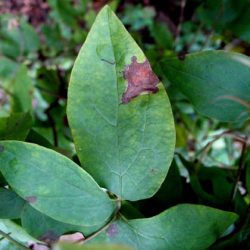
What diseases and pests can occur in clematis?
Clematis diseases
Clematis wilt = Phoma Clematidina (former name Ascochyta Clematidina)
The No.1 topic in the cultivation of clematis. All clematis can be affected, but mainly large-flowered hybrids can perish. In the case of small-flowered species, there is usually only a latent infection that is hardly noticed. Such affected clematis are resistant or even immune and do not die from it! Phoma is a vascular parasitic fungal disease that can affect all parts of the clematis plant. (leaves, stems and roots). This fungal disease is usually introduced unnoticed. The leaves are always infested first! This initially manifests itself as small irregular spots in the lower part of the “new” clematis. An infection attacks from the underside of the leaf and then penetrates the entire leaf tissue, which eventually turns brown and dies.
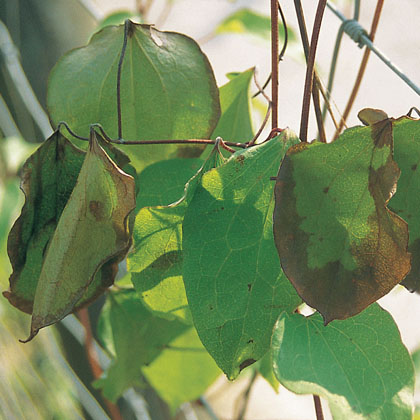
An infection progresses quickly from the bottom up. Temperature, light conditions and the presence of water play a decisive role here. The fungal spores may also have been carried over many kilometers or come from the immediate vicinity. The fungal spores can only establish and sprout if water is available for several hours and temperatures are well above 20°. Other infection factors are: Damage to shoots, especially near the ground, or direct root damage if fungal spores have been washed into the soil. This infection often occurs in the second or third year after planting. The latter always happens if a leaf infection has previously occurred or the newly purchased clematis has already brought the fungal spores with it in the pot. When buying new plants, particular care must be taken to ensure that the lower leaves do not have any brown spots, however small they may be. Once the disease is present, it is almost impossible to combat.
The only way to permanently establish healthy clematis in the garden is to use small-flowered clematis species and their varieties!

What can be done to prevent this disease? The highest priority is to purchase healthy plants. If possible, position the clematis so that the foliage can dry quickly after rainfall.
Water and irrigate in such a way that the foliage remains dry. Choose an airy and cool location, because the cooler the better. Wind movement also helps to keep clematis healthy. If you recognize the first signs of a leaf infection, it is helpful to remove the infected leaves immediately.
Control measures can be initiated with various fungicides.
Fungicides that are commercially available against various leaf spots can be used. Biological agents are also available. Here, Trichoderma fungi and Bacillus subtilis are the most common and available antagonists. Various plant strengthening agents can also be used to help.
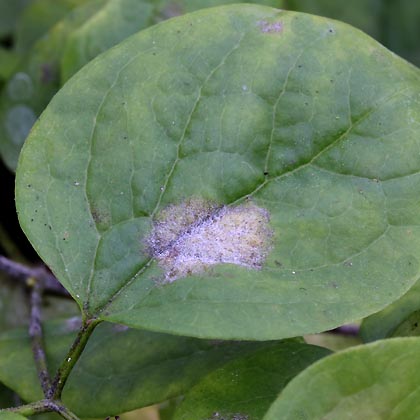
Powdery mildew
is widespread and occurs on many other plants. Native shrubs, perennials and ornamental plants can also be infested. Fortunately, only a few clematis are affected. The weather has a major influence on the spread of mildew. In clematis, infection usually begins in late summer or fall. As winter dormancy is already imminent at this time, major damage is not to be expected. Powdery mildew penetrates the surface of the leaves and can be recognized by a mealy, white coating on the stems and then on the leaves. Later, flowers can also be infested. Black spots become visible in the late stages. Powdery mildew is still easy to combat in the early stages. If you wait too long, it becomes much more difficult to eliminate mildew.

Downy mildew
differs from powdery mildew in that it is mainly found on the underside of the leaves and penetrates much deeper into the plant tissue. This is a rather gray coating that looks furry. The upper side of the leaf turns pale green, then yellow and later brown-black. Downy mildew rarely occurs.

Gray mold
is a weak parasite and occurs primarily in high humidity. A lack of light can also lead to the spread of gray mold (Botrytis). This usually first manifests itself on the older leaves in the lower part of the plants. Young shoots can also be infested under extreme infestation pressure.

Various root diseases
such as Pythium, Phytophthora, Rhizoctonia and Fusarium can damage clematis in the root area. These diseases are often confused with clematis wilt, because at first glance they look similar. The diseases mentioned can occur on many cultivated plants or be introduced by them. Clematis collapse within a short time after infection. Waterlogging and insufficient drainage are often the causes.
Clematis pests
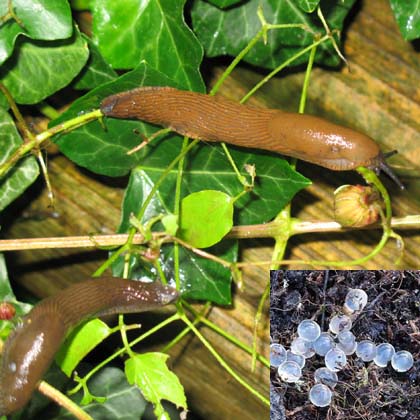
Snails
are the main enemies of clematis. It is mainly slugs that can cause major damage to clematis. Whole shoots fresh from the soil can be damaged just as much as leaves or flowers. Snails are nocturnal and hide near the plants in dark, damp places during the day. Control: In addition to collecting at dusk, chemical agents are also available. Plant pathogenic nematodes can be used for biological control.
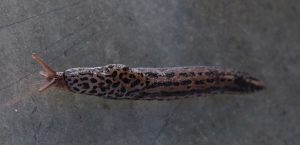
Important to know!
There are also “useful helpers” among the slugs. The tiger snail. It eats other nudibranchs and their eggs. Furthermore, it lives only on dead plant parts and fungi. Not from green plant material! It should not be removed under any circumstances. Look out for them on your next garden tour. Not all nudibranchs are the same. Unfortunately, far too few garden owners are aware of this.
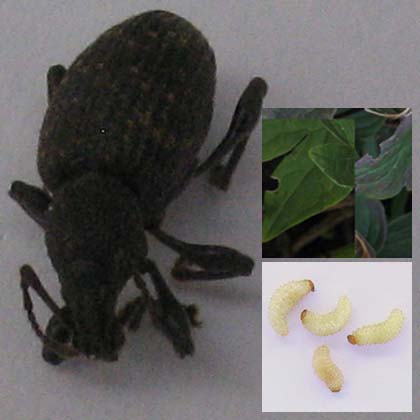
Weevils and their larvae
For many years I have been observing the large spread of weevils on numerous crops. These persistent problem pests are mainly found on hard-leaved plants. When I look at rhododendrons, in gardens or in public green spaces, it becomes clear how big the problem can be. Roses and many garden shrubs can also be infested.
So far, the damage to clematis is still minor, but it is important to keep an eye on the problem. Typical is the feeding on the leaves. The nocturnal beetles cannot be seen during the day and only come out at dusk. Worse are actually the larvae of weevils, because they feed on the roots or the root collar. Growth depression is the result and the resulting wounds create entry points for fungal diseases.
There are very effective biological agents for controlling weevil larvae.
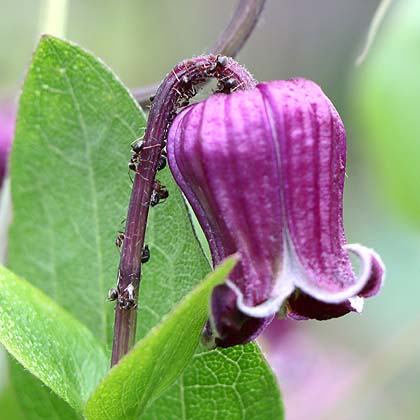
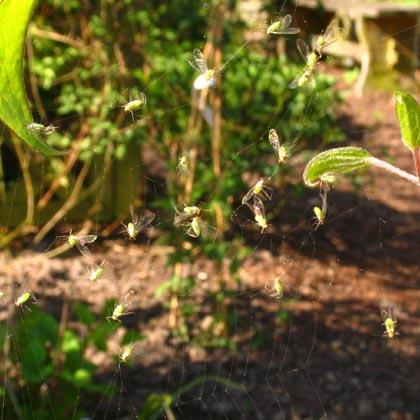
Aphids
can occur on all cultivated plants. They cause damage by sucking on the plant sap. The first generation of aphids to hatch from the winter eggs is winged and spreads through our gardens at the end of April. One wonders where they suddenly come from. Wind and rain transport the aphids over several hundred meters. Later in the summer, ants can also spread the aphids. If the infestation is severe, the shoot tips and leaves can be affected and stunted. Because many aphids are greenish, they are often only recognized late. Natural enemies are our small songbirds. If you create nesting opportunities, you will hardly have any problems with aphids. The same applies to harmful caterpillars. (see next article) Aphids are easy to control; if you want to get by without chemicals, you can use biocides.

Caterpillars
cause feeding damage in the period from May to October. The misshapen feeding holes are clearly visible and can be mistaken for snail feeding. However, no traces of mucus are visible here. They usually hide on the underside of the leaves and are not noticed. The control is comparable to the control of aphids. Many pesticides are effective against both sucking and biting insects.
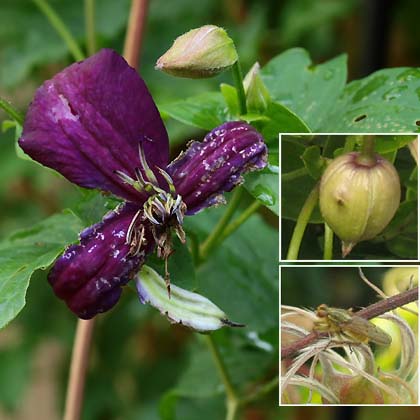
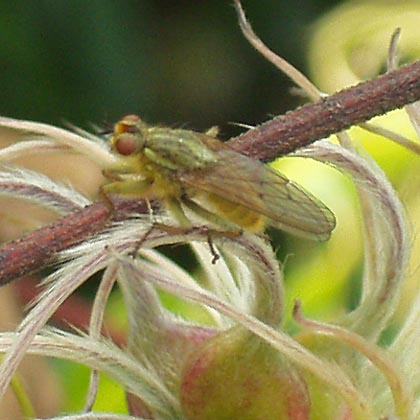
For several years we have been observing a strong increase in Phytomyza clematidis
A fly whose larvae cause crippling of the flowers. It has spread northwards from southern Europe. There is a certain time window during which the fly is active, by piercing the still closed flower buds and laying its eggs. The larvae hatch from these and eat the stagnant vessels while the bud is still closed. Even the buds themselves are not spared. They are slightly curved or misshapen. As time goes on, the crippling becomes more and more obvious. The time window for this damage is the month of May and this only becomes apparent in June, for example when Clematis viticella opens its first flowers. Clematis that flower earlier or much later are not affected. Control can also be carried out with various insecticides or biocides. Timely or preventive treatment is particularly recommended here.
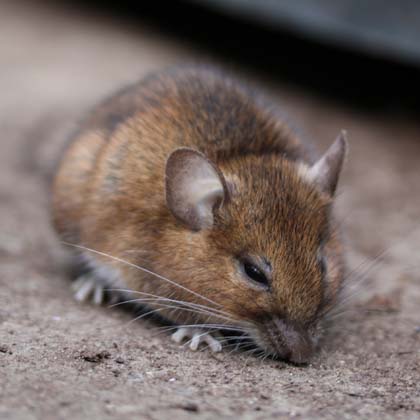
Mice:
Various types of mice such as voles, field mice or house mice can cause damage to clematis. Voles feed on the roots and the result is that the clematis no longer grow quickly or stagnate. Occasionally they perish completely. Field mice or house mice feed on the above-ground parts. The stems are gnawed through and the sap flow is interrupted. A “withered appearance” becomes visible. The clematis looks as if the shoots have been cut through.
Other pests that can occur on clematis are earwigs, thrips, flower thrips, rapeseed weevils and spider mites.
